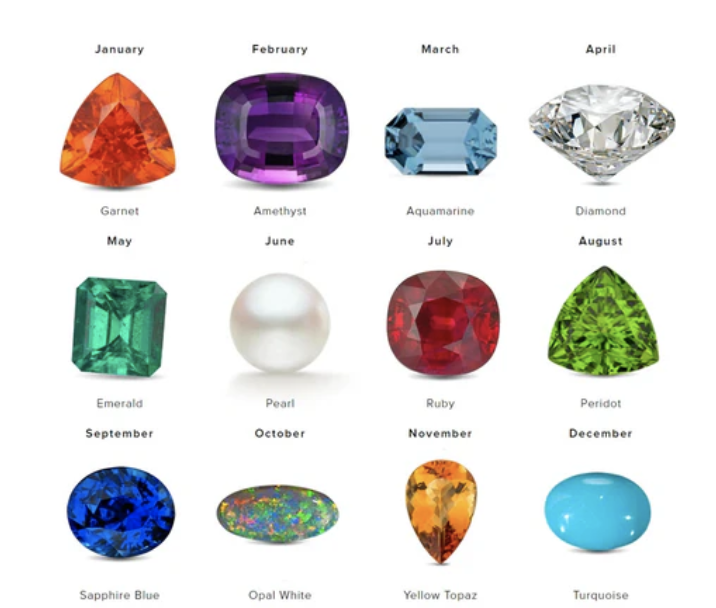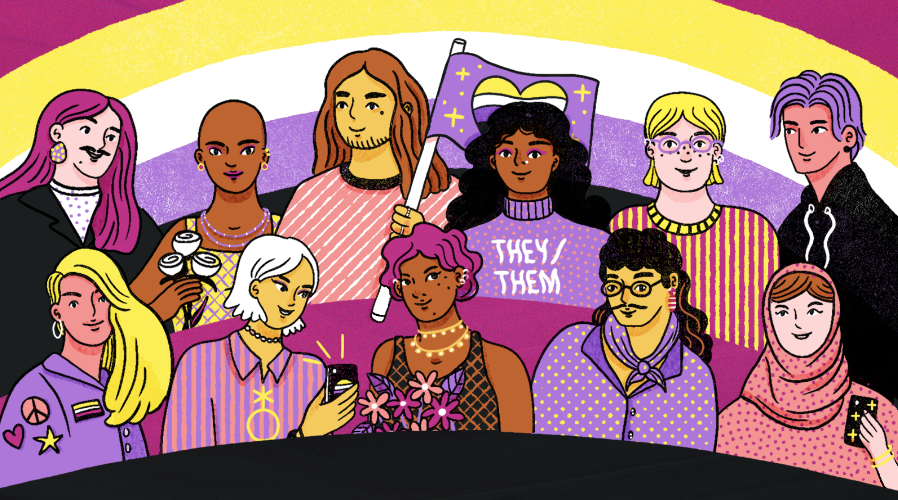What It Means to Be Non-Binary
Courtesy of Alison Czinkota / Verywell
Gender identity and sexuality is a spectrum. This cartoon perfectly depicts the fact that gender does not have a specific look, but in fact, varies from person-to-person. Non-binary individuals are not confined to their sex and are not exclusively feminine or masculine.
October 18, 2020
Around 180 million years ago, the scientific distinction between males and females was established (ScienceDaily). The genetic definition of gender lies in chromosomal makeup, specifically in the Y chromosome. The Y chromosome differentiates males and females, as a Y chromosome represents males, while an X chromosome represents females.
Although, this science solely considers sex, seemingly disregarding gender. Sex and gender tend to be grouped as having similar definitions, but the two hold entirely different ideas. In their definitions, it is evident that sex “refers to the biological differences between males and females, such as the genitalia and genetic difference”, whereas gender “refer[s] to the role of a male or female in society, known as a gender role, or an individual’s concept of themselves, or gender identity” (MedicalNewsToday).
So, when someone’s sex does not synch with their gender, they often identify among the LGTBQ+ community, commonly as transgender, gender-nonconforming, and non-binary.
Non-binary, according to the Definitions from Oxford Languages, is “not relating to, composed of, or involving just two things”; however, non-binary can have very different meanings to different people.
A non-binary YLHS student elucidated that “to [them], it essentially means that [they are] not a boy or a girl.” This simple idea seems to be quite confusing to many, but like this student stressed, “Gender is scientifically not attached to sex, and some people just identify outside of the strict man/woman binary.”
One of the main distinctions of one’s gender lies in pronouns. Most commonly, we hear “he/him” and “she/her” as, according to societal constructs, these are the more acceptable pronouns. But, those identifying as non-binary tend to use “they/them” pronouns as a result of their unconfined identity.
Due to social constructs that have persisted for years, deeming what is “allowed” under today’s standards, many find difficulty in adapting to someone’s pronouns, and others just blatantly deny them. When it comes to the accidental use of the wrong pronouns, a YLHS student ensures that “no one is perfect.” Considering that many have “grown up in a society that really enforces sticking with your assigned gender at birth, all you can do is try your best to use the correct pronouns and not invalidate another person.”
Society has pressed the idea that there are only two identifiable genders, so adapting to someone’s pronouns is surely an adjustment. As long as people remain respectful and do their best to use the individual’s established pronouns, the YLHS student confirms that “no offense is taken.”
Also, a major reminder the YLHS student emphasized was the harm of a term often portrayed in the media, “preferred pronouns.” While this phrase is often used with good intent, it, according to the student, “implies that those pronouns are not necessarily the correct ones when in fact, they are the person’s actual pronouns.” They followed by substantiating that “A qualifier isn’t needed because pronouns aren’t a preference but rather what a person is or wants to be identified as.”
The meaning of “prefer”, as stated by Definitions from Oxford Languages, is to “like (one thing or person) better than another or others; tend to choose.” While most often those using the term “preferred pronouns” are not coming from ill-intentions, it implies that while “they/them” pronouns are their first choice, there remain other pronouns that could be used. The most common non-binary pronouns include they/them/their, and that is what should be used if specified. Simply, there is no alternative to what someone wants to be referred to as.
Thankfully, as years have gone by, there has been major progress for the LGBTQ+ community. Back in 2015, America hit a major milestone for human rights, as gay marriage was finally legalized. Also, there have been more anti-discriminatory policies toward LGBTQ+ workers implemented in businesses than ever before.
Instrumental strides have been taken towards an overall, more accepting, and safe space for those in the LGTBQ+ community, but some groups, specifically non-binary individuals, seem to receive less support. Unfortunately, the idea of being non-binary, as stated by the YLHS student, continues to be perceived as “a more foreign concept.” As societal constructs of gender persist, those identifying as non-binary will remain discriminated against.
It is important to remember that every individual has very different experiences and thoughts when it comes to gender identity and sexuality. The student mentioned throughout this article is no exception to that.
Moving forward in a world that is constantly changing, it is important and necessary to be educated. If you do not identify among the LGBTQ+ community, be an ally, and show support for those who are often dismissed by so many. Do your best in using the correct pronouns and, like Shayda Roshdieh (12) reminds, “Be respectful and kind to others; it’s easy!”
Now more than ever, the need for positivity and compassion towards others is paramount. From the deadly virus plaguing countries across the globe, to the intense political differences dividing our nation, it is clear that any sense of light during these dark times is valuable. Respecting others’ sexual identities and pronouns is one of the few ways to contribute to the progress the world is desperately seeking in these uncertain circumstances. Educate yourself and be a part of the positive change!








































Kylie de Best • Oct 23, 2020 at 1:53 PM
I became a lot more educated on this topic by reading your article. Thank you for explaining about this topic.
Karina Shah • Oct 22, 2020 at 7:37 AM
I really appreciate how educational and inclusive this article is!